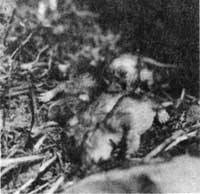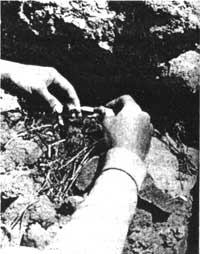Pack Rats
 “The youngsters…had dainty pink noses and feet.” |
The naturalists had been annoyed by an unknown nightly visitor to the Information Building during the month of July, that left disorder in its wake. The flowers so carefully arranged for display were chewed off and scattered in distant parts of the room. Traps in numbers were set for the villain, but they were untouched during the night. Tidbits of cheese, candy, peanut butter, even the flowers so avidly stolen from the display table would not entice the pilferer to his capture.
The end was sudden; a female pack rat was discovered in the wood pile on July 31 and was quickly dispatched. But this did not make an end of the episode. The next morning, upon opening the building, we heard hungry squeals coming from above. Upon investigation, the rat’s nest was found upstairs and within it four babies. The heterogeneous components of the structure included four of the traps that had been set out, two large signs used on the self-guiding nature trails, bits of rocks, paper and wood. The interior was snugly lined with fur from the mother and small pieces of newspaper.
 “They were fed cream sweetened with syrup through a medicine dropper to which they clung with eagerness.” |
The youngsters, only two or three days old, with pelage still matted, had dainty pink noses and feet. The eyes had not yet opened, nor did they open during the next three days of pampered but forced residence at Park Headquarters. The young measured two inches in length with naked tails about three-quarters of an inch long. They were fed cream sweetened with syrup through a medicine dropper to which they clung with eagerness. A small feeding was required at least every half-hour, but my maternal efforts were insufficient to sustain the delicate thread of life within them. After all, they had endured a long day’s hunger when mother had made her demise.
The flowers now remain undisturbed on the display table during the night. No longer need the naturalists go afield each morning with vasculum under arm in search of fresh blossoms to show park visitors. The benefits of the nocturnal rearrangement and disposal have come to an end, but another yarn has been added to the many involving this character of prankish caprice.
Muskrat Record
On August 8, 1951, I found an adult muskrat on the park highway four miles north of the South Entrance. Apparently it had been hit by a car as it was attempting to cross the road. As Annie Creek nearby has cut a deep canyon with sheer walls, it seems quite unlikely that the animal was making that creek its home. Muskrats are known to rove or migrate considerable distances in the fall. Possibly this individual was in search of a new home.
Butterflies of Crater Lake National Park
An early collection of butterflies of Crater Lake National Park was made by Dr. H. A. Scullen in 1930 who served as a ranger naturalist that year. No attempt is made to give a complete list of park butterflies here, for a comprehensive collection should yield fifty to a hundred different species. A short discussion is given of the specimens collected by Scullen and those observed by me in the park during the past summer. The butterflies are to be commonly found in several general localities. Principally they are abundant on and in the vicinity of flowers. Secondly, they are likely to be found near streams and in moist places where they try to imbibe water from the wet earth.
Among more common species captured or observed are the following: Western Parsley Swallowtail, Parnassius, several whites and sulphurs, satyrs or wood-nymphs, fritillaries, checker-spots, angle-wings, California Tortoise Shell, Mourning Cloak, Painted Lady, Admiral, Nivalis Copper, several species of little blues, and several skippers.
The California Tortoise Shell was the species that most captured the attentions of park visitors this year. Beginning before August 1, this butterfly appeared in vast numbers on the slopes of Mt. Mazama. The same phenomenon had occurred in 1930 and 1931 according to park records, as well probably as in intervening years when no note was made of the irruption. California lilac or snowbush (Ceanothus) is the food plant of the larvae. 1951 must have been an exceptionally propitious season for these insects, for they developed in vast numbers. The main migration lasted about ten days, though many specimens could still be seen by the end of August. On September 5, hordes were seen migrating southward over the top of Mt. Scott. They were performing in interesting activity on the south rock slope of Mt. Thielsen where I saw them still in abundance on August 20. Many had secreted themselves beneath the rocks, from which they would pop out and fly away as I disturbed them by walking over their retreat.
Most of the time, the tortoise shells were flying in great numbers mainly in one direction, upward. The significance of such migration is not understood, though presumably the females, forced outward by population density, were in search for host plants on which they could lay their eggs. The area in which adults emerge has been shown in some cases to be almost entirely denuded of leaves. Consequently the young would have little on which to live if eggs were deposited in the same vicinity. Regardless of the cause, the fact of migration or wandering has impressed observers during years when conditions are right for its occurrence.
Many species of butterflies are found at high altitudes in the vicinity of the rim, 6000 to 8000 feet, that do not occur elsewhere. Of these, three species, Parnassius, Nivalis Copper, and Pine-white, were collected and frequently seen this year.
The larvae of Parnassius feed on stonecrop (Sedum) and saxifrage which are common plants at high altitudes. The adults are quite common, flitting around the trails and meadows from Tulare County, California into Oregon. It is a white to cream-colored insect with black spots and short black bands on its front wings and a pair of small red or orange spots bordered with black on each hind wing. The wing spread is about two and a half inches.
The pine-white, also mainly a high altitude form, is likewise white in color, but much smaller (1-3/4 inches wing spread) and having only black markings. A black band on the forward edge of the front wings extends from the body about half way out to the side where it curves inward towards the center of the wing. The tips of the fore wings are black with an enclosed white pattern. The remainder of the wings are marked only lightly with dusky scales along the wing veins. The larvae feed on pine trees. When ready to change to the adult stage, the larva lets itself down to the ground by a long thread. In the ground, it goes into the pupal stage to emerge the next spring as the adult butterfly.
The following list arranged in taxonomic order, includes the species of which specimens have been collected or definitely identified in the field.
Western Parsley Swallowtail – Papilio zelicaon Lucas
Parnassius – Parnassius clodius baldur Edw.
Pine White – Neophasia menapia F & F
Becker’s White – Pieris beckeri Edw.
Common White – Pieris protodice vernalis Edw.
Boisduval’s Sulphur – Eurymus eurytheme Bdv.
Wood Nymph – Cercyonis alope Fabr.
Fritillary – Argynnis sp.
Segregated Checker Spot – Melitaea hoffmanni segregata B & McD.
Angle Wing – Polygonia faunus Edw.
California Tortoise shell – Aglais californica Bdv.
Milbert’s Tortoise shell – Aglais milberti Godt.
Mourning Cloak – Aglais antiopa Linn
Virginia Lady – Vanessa virginiensis Dru.
West Coast Lady or Malva Butterfly – Vanessa carye Hon.
Lorquin’s Admiral – Basilarchia lorquini Bdv.
Nivalis Copper – Heodes nivalis Bdv.
Acmon Blue – Plebeius acmon West. & Hew.

